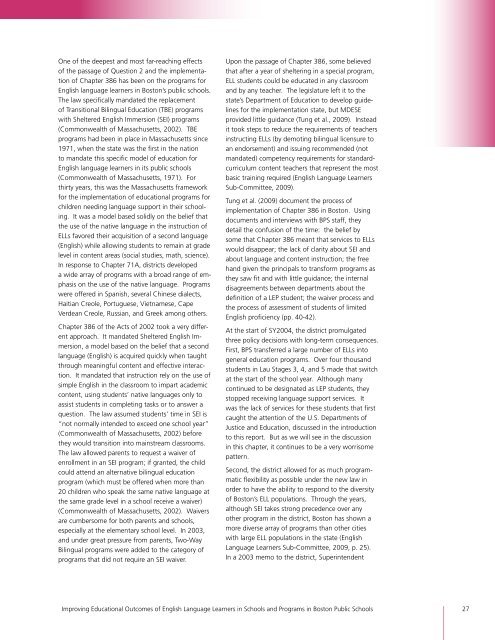Full Report - Center for Collaborative Education
Full Report - Center for Collaborative Education
Full Report - Center for Collaborative Education
Create successful ePaper yourself
Turn your PDF publications into a flip-book with our unique Google optimized e-Paper software.
One of the deepest and most far-reaching effects<br />
of the passage of Question 2 and the implementation<br />
of Chapter 386 has been on the programs <strong>for</strong><br />
English language learners in Boston’s public schools.<br />
The law specifically mandated the replacement<br />
of Transitional Bilingual <strong>Education</strong> (TBE) programs<br />
with Sheltered English Immersion (SEI) programs<br />
(Commonwealth of Massachusetts, 2002). TBE<br />
programs had been in place in Massachusetts since<br />
1971, when the state was the first in the nation<br />
to mandate this specific model of education <strong>for</strong><br />
English language learners in its public schools<br />
(Commonwealth of Massachusetts, 1971). For<br />
thirty years, this was the Massachusetts framework<br />
<strong>for</strong> the implementation of educational programs <strong>for</strong><br />
children needing language support in their schooling.<br />
It was a model based solidly on the belief that<br />
the use of the native language in the instruction of<br />
ELLs favored their acquisition of a second language<br />
(English) while allowing students to remain at grade<br />
level in content areas (social studies, math, science).<br />
In response to Chapter 71A, districts developed<br />
a wide array of programs with a broad range of emphasis<br />
on the use of the native language. Programs<br />
were offered in Spanish, several Chinese dialects,<br />
Haitian Creole, Portuguese, Vietnamese, Cape<br />
Verdean Creole, Russian, and Greek among others.<br />
Chapter 386 of the Acts of 2002 took a very different<br />
approach. It mandated Sheltered English Immersion,<br />
a model based on the belief that a second<br />
language (English) is acquired quickly when taught<br />
through meaningful content and effective interaction.<br />
It mandated that instruction rely on the use of<br />
simple English in the classroom to impart academic<br />
content, using students’ native languages only to<br />
assist students in completing tasks or to answer a<br />
question. The law assumed students’ time in SEI is<br />
“not normally intended to exceed one school year”<br />
(Commonwealth of Massachusetts, 2002) be<strong>for</strong>e<br />
they would transition into mainstream classrooms.<br />
The law allowed parents to request a waiver of<br />
enrollment in an SEI program; if granted, the child<br />
could attend an alternative bilingual education<br />
program (which must be offered when more than<br />
20 children who speak the same native language at<br />
the same grade level in a school receive a waiver)<br />
(Commonwealth of Massachusetts, 2002). Waivers<br />
are cumbersome <strong>for</strong> both parents and schools,<br />
especially at the elementary school level. In 2003,<br />
and under great pressure from parents, Two-Way<br />
Bilingual programs were added to the category of<br />
programs that did not require an SEI waiver.<br />
Upon the passage of Chapter 386, some believed<br />
that after a year of sheltering in a special program,<br />
ELL students could be educated in any classroom<br />
and by any teacher. The legislature left it to the<br />
state’s Department of <strong>Education</strong> to develop guidelines<br />
<strong>for</strong> the implementation state, but MDESE<br />
provided little guidance (Tung et al., 2009). Instead<br />
it took steps to reduce the requirements of teachers<br />
instructing ELLs (by demoting bilingual licensure to<br />
an endorsement) and issuing recommended (not<br />
mandated) competency requirements <strong>for</strong> standardcurriculum<br />
content teachers that represent the most<br />
basic training required (English Language Learners<br />
Sub-Committee, 2009).<br />
Tung et al. (2009) document the process of<br />
implementation of Chapter 386 in Boston. Using<br />
documents and interviews with BPS staff, they<br />
detail the confusion of the time: the belief by<br />
some that Chapter 386 meant that services to ELLs<br />
would disappear; the lack of clarity about SEI and<br />
about language and content instruction; the free<br />
hand given the principals to trans<strong>for</strong>m programs as<br />
they saw fit and with little guidance; the internal<br />
disagreements between departments about the<br />
definition of a LEP student; the waiver process and<br />
the process of assessment of students of limited<br />
English proficiency (pp. 40-42).<br />
At the start of SY2004, the district promulgated<br />
three policy decisions with long-term consequences.<br />
First, BPS transferred a large number of ELLs into<br />
general education programs. Over four thousand<br />
students in Lau Stages 3, 4, and 5 made that switch<br />
at the start of the school year. Although many<br />
continued to be designated as LEP students, they<br />
stopped receiving language support services. It<br />
was the lack of services <strong>for</strong> these students that first<br />
caught the attention of the U.S. Departments of<br />
Justice and <strong>Education</strong>, discussed in the introduction<br />
to this report. But as we will see in the discussion<br />
in this chapter, it continues to be a very worrisome<br />
pattern.<br />
Second, the district allowed <strong>for</strong> as much programmatic<br />
flexibility as possible under the new law in<br />
order to have the ability to respond to the diversity<br />
of Boston’s ELL populations. Through the years,<br />
although SEI takes strong precedence over any<br />
other program in the district, Boston has shown a<br />
more diverse array of programs than other cities<br />
with large ELL populations in the state (English<br />
Language Learners Sub-Committee, 2009, p. 25).<br />
In a 2003 memo to the district, Superintendent<br />
Improving <strong>Education</strong>al Outcomes of English Language Learners in Schools and Programs in Boston Public Schools 27


